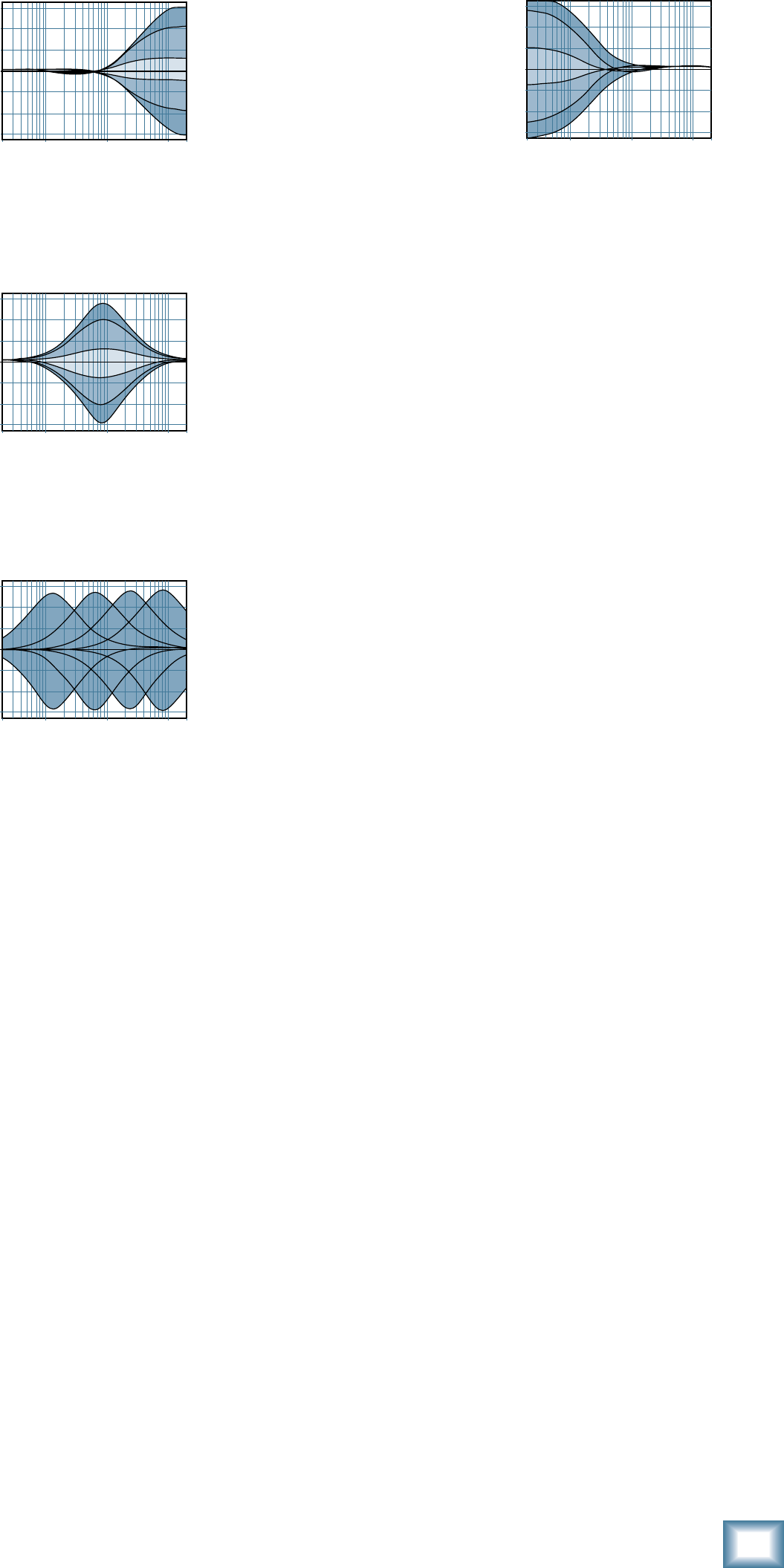
19
Owner’s Manual
Owner’s Manual
20
Hz
100
Hz
1k
Hz
10k
Hz
20k
Hz
–15
–10
–5
0
+5
+10
+15
20
Hz
100
Hz
1k
Hz
10k
Hz
20k
Hz
–15
–10
–5
0
+5
+10
+15
20
Hz
100
Hz
1k
Hz
10k
Hz
20k
H
z
–15
–10
–5
0
+5
+10
+15
20
Hz
100
Hz
1k
Hz
10k
Hz
20k
Hz
–15
–10
–5
0
+5
+10
+15
27. HIGH EQ
The high EQ provides up to 15
dB of boost or cut above 12 kHz,
and it is also fl at at the detent.
Use it to add sizzle to cymbals,
an overall sense of transpar-
ency, or an edge to keyboards,
vocals, guitar and bacon frying. Turn it down a little to
reduce sibilance or to mask tape hiss.
28. MID EQ LEVEL (Ch. 1 to 8)
The mid EQ , or “midrange,”
has a fi xed bandwidth. The mid
knob sets the amount of boost
or cut, up to 15 dB, and is ef-
fectively bypassed at the center
detent. The frequency at which
the cut or boost occurs is set by
the mid EQ frequency control [29].
29. MID EQ FREQUENCY (Ch. 1 to 8)
This knob sets the center
frequency of the mid EQ level
control [28]. This is sweepable
from 100 Hz to 8 kHz.
Once this is set, the mid EQ
level can be adjusted with the
mid EQ level control.
Most of the root and lower harmonics that defi ne
a sound are located in the 100 Hz–8 kHz frequency
range, and you can create drastic changes with these
two knobs. Many engineers use mid EQ to cut midrange
frequencies, not boost them. One popular trick is to set
the mid fully up, turn the frequency knob until you fi nd
a point where it sounds just terrible, then back the mid
down into the cut range, causing those terrible frequen-
cies to disappear. Sounds silly, but it works. Sometimes.
30. HIGH MID EQ LEVEL (Ch. 9/10 and 11/12)
The high mid EQ provides up to 15 dB of boost or cut
at 2.5 kHz, and it is also fl at at the detent. This control
is only available on the stereo channels.
31. LOW MID EQ LEVEL (Ch. 9/10 and 11/12)
The low mid EQ provides up to 15 dB of boost or cut
at 400 Hz, and it is also fl at at the detent. This control is
only available on the stereo channels.
32. LOW EQ
The low EQ provides up to 15
dB of boost or cut below 80 Hz.
The circuit is fl at (no boost or
cut) at the center detent posi-
tion. This frequency represents
the punch in bass drums, bass
guitar, fat synth patches, and some really serious male
singers who eat raw beef for breakfast.
33. MON 1 AUX SEND and
34. MON 2 AUX SEND
These controls allow you set up two independent
mixes for running stage monitors.
Adjust these controls on each channel until your band
is happy with the stage monitor mix. The controls are
off when turned fully down, deliver unity gain at the
center, and can provide up to 15 dB of gain turned fully
up. Chances are you’ll never need this extra gain, but
it’s nice to know it’s there if you do. Adjustments to the
channel faders [40] or main mix fader [59] will not
affect the monitor output, but channel EQ [27–32] and
gain [23] will.
One or both of the powered mixer's internal amplifi ers
can be used to power passive stage monitors if you set
the power amp mode switch [53].
Mon 1 and mon 2 send [10] are line-level outputs, and
are used if you want to connect powered stage monitors,
or external power amps with passive stage monitors.
35. FX1 AUX SEND and
36. FX2 AUX SEND
These controls allow you set up two independent
mixes for the internal effects processors, or external
effects processors.
Adjust these controls on each channel until you have
just the right level going to the internal processors. The
controls are off when turned fully down, deliver unity
gain at the center detent, and can provide up to 15 dB of
gain turned fully up. Adjustments to the channel fader
[40], gain [23] and channel EQ [27–32] will affect the
feed going to the internal effects processors.
The FX1 and FX2 send [11] outputs are line-level,
and are used if you want to connect external effects pro-
cessors. If you plug something into these outputs, the
feed to the internal processors is disconnected, and the
FX1 and FX2 mixes feed the external processor(s) only.


















